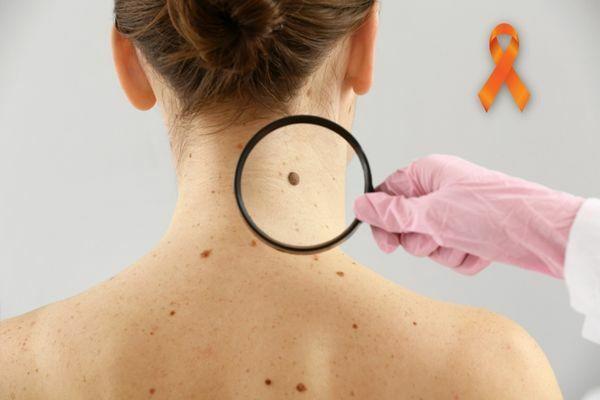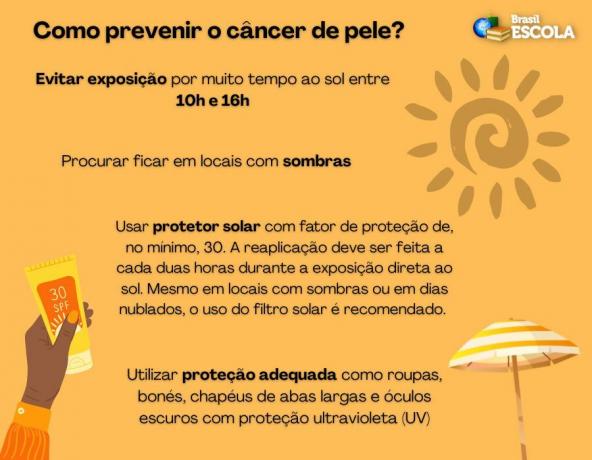O skin cancer is the subject of the awareness campaign December Orange. The initiative aims to inform and warn about the disease.
Created in 2014 by the Brazilian Society of Dermatology (SBD), the December Orange campaign promotes actions to share knowledge and contribute to the prevention of skin cancer.
The annual average of cases of non-melanoma skin cancer in the last three years is 83,770 in men It is 93,170 in women, according to the Ministry of Health.
Check out:the myths and truths about skin cancer
What is skin cancer?
Skin cancer is characterized by abnormal and uncontrolled growth of the cells that make up human skin, according to SBD.
The disposition of these cells it forms different layers, and depending on the layer affected, the specific type of skin cancer is characterized.
Know more: how cancer arises, causes, types, diagnosis and treatment
Main causes of skin cancer
The main cause of skin cancer is chronic exposure to ultraviolet radiation, according to Bruno de Castro e Souza, an oncology dermatologist at the Specialized Oncology Center at the Alemão Oswaldo Cruz Hospital.
Bruno explains that there are two types of ultraviolet rays: UV A and UV B. The latter being the one that is most closely related to cases of skin cancer, as they occur between 10 am and 4 pm, when the sun's rays are strongest.

Credit: Shutterstock
According to the professional, people from skin Clara are more susceptible to developing skin cancer. And genetic history may be associated with cases of melanoma-type skin cancer.
types of skin cancer
The types of skin cancer can be divided into melanoma and non-melanoma, says Bruno de Castro.
O Basal cell carcinoma and the squamous cell carcinoma are two non-melanoma types. According to the oncology dermatologist, these cancers are born from keratinocyte cells, which are responsible for building the base of our skin.
These two types are the most common. The manifestations of these cancers are mostly non-aggressive. Bruno reinforces that the probability that they reach metastasis is low. The cure percentages are high.
Now the skin cancer melanoma comes from melanocytes, the cells responsible for producing melanin in the human body. This type is more aggressive.
Dermatologist Bruno emphasizes the importance of early diagnosis, especially of melanoma, to prevent the evolution of the severe form of the disease. Despite the high level of lethality, melonoma skin cancer can reach a 90% chance of cure.
Read too: Is a tumor cancer?
skin cancer symptoms
It is essential to be aware of the appearance of spots, moles and lesions on the skin, which may indicate a sign of skin cancer. It is worth noting that not all spots can be a type of cancer.

Credit: Shutterstock
Learn some types of signs and changes to watch out for:
Spots with irregular edges; that have increased in size; with variation in color and texture.
Elevated lesions, which have a rough texture with a depression in the center;
Lesions that bleed easily
Reddish region that itches and falls;
Wounds that don't heal
Dermatologist Bruno de Castro reinforces that moles that may be melanoma skin cancer are different from the others. He quotes the ABDCE self-examination, consisting of rules and aspects about the mole that must be analyzed for a possible diagnosis:
A - Asymmetry
B - Irregular edges of the lesion
W - multiple colors
D - Diameter greater than 6mm
AND - Evolution, which presents a change of aspect
If the mole has one or more of the characteristics mentioned above, it is necessary to seek a dermatologist to assess the case, says the doctor.
See too:the characteristics between benign and malignant tumors
skin cancer prevention
Check out the ways to prevent skin cancer:

Information from the Ministry of Health.
Do not stop now... There's more after the publicity ;)
skin cancer treatment
In cases of suspected skin cancer, Isabel Saraiva, a dermatologist at the Specialized Center for Oncology at Hospital Alemão Oswaldo Cruz, explains step by step and the characteristics of each type of treatment.
Biopsy
The first step is the biopsy, an exam that confirms the diagnosis of skin cancer. The procedure is simple and can be done on the same day as the consultation, with local anesthesia.
A small sample of the lesion is taken. With this, the laboratory will evaluate the sample using a microscope.
Surgery
Surgical procedures are defined according to the type of skin cancer. See the details for each type:
"For the Basal cell carcinoma and the squamous cell, the two most common types, can be performed: curettage and electrocautery of the lesion, simple removal of the tumor with a safety margin which revolves around 4 mm or the removal of the lesion with examination of the margins still at the time of surgery", advises dermatologist Isabel Saraiva.
The choice of method, explains Isabel, depends on the characteristics of the tumor and the patient himself. Among these aspects are: tumor subtype, size, location, borders of the lesion and the degree of immunosuppression of the patient.
According to dermatologist Isabel, for all types of skin cancer, surgery is the gold standard treatment.
"Selected cases of basal cell carcinoma or squamous cell carcinoma, which are small, are still superficial and are located in areas considered low risk can be treated with topical medications that the patient applies at home or with photodynamic therapy, procedure performed in the office, in which a cream is applied that will later be activated by a light for specific destruction of the cancer.
Very advanced cases may require major surgery, radiotherapy and joint follow-up with the clinical oncologist who can prescribe, depending on the case, chemotherapy, targeted therapy or immunotherapy."Isabel Saraiva - Dermatologist
malignant melanoma: enlargement of the margins of the lesion is indicated. According to the thickness of the tumor identified in the biopsy, the margin to be used in the surgery is determined. It can vary from 0.5 cm to 2 cm.
Read more:advances in cancer treatment
By Lucas Afonso
Journalist

